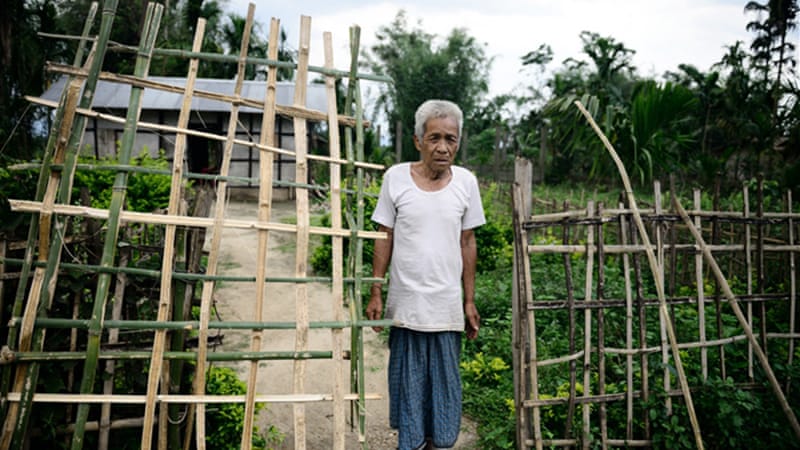7 decades ago, a line was drawn across the Indian subcontinent, dividing the inviolable Indian nation into Hindu and Muslim dominated parts. As a consequence of this partition, Chittagong Hill tracts, which was almost 100% non-Muslim was awarded to Pakistan. The Hill tracts, described as the last abode of Buddhism in the Indian subcontinent was populated by various tribes and sub tribes, most of whom followed Buddhism. One of these tribes, known as Chakmas, formed the demographic majority in the Chittagong Hill tracts. Apart from the numerically preponderant Chakmas, other smaller tribes, such as Buddhist Tanchangya, Marma and Hindu Hajongs also inhabited the hill tracts.
During the British era, the Hill tracts enjoyed substantial autonomy and were governed as a unique administrative unit. Unfortunately, the replacement of benign British rule with the more religiously inclined Pakistani and Bangladeshi governance spelled doom for the inhabitants of the Hill tracts. Under the guise of development by construction of Kaptai dam, the Pakistani government forced thousands of indigenous tribals to flee and seek shelter in India. It is estimated that with their farmlands inundated and no compensation coming their way, as many as 40,000 tribals fled to India.
In this way, Chakmas, Hajongs and other tribals began to trickle out of the hills into Indian states of Mizoram and Tripura.
The government of India, struggling with the refugees resettled some of them in Arunachal Pradesh, where generations of refugees have lived without rights and citizenship.
All this is about to change, with the Union government declaring its intent to grant the refugees Indian citizenship.
Who are the Chakmas and Hajongs:
Chakmas are Tibeto-Burmans whose original homeland was in Burma. Sometime in the past, they spread out into parts of North East India and present day Bangladesh. The word Chakma stems from the Sanskrit word Shaktiman, which was appellation used by the Burmese to describe them. Chakmas were famed as ministers and strategists and wielded substantial power in courts of Burmese Kings.
Followers of Thervada Buddhism, Chakmas eventually became the dominant community in the Chittagong Hill tracts.
At the time of partition, Chakmas opposed the inclusion of their territories into Muslim dominated Pakistan. Ethnically too, Chakmas were distinct from the neighbouring Bengali community and faced discrimination at the hands of Bengalis. Chakmas suffered immense damage as infrastructure projects such as Kaptai dam forced them to seek refuge in India.
At the time of Bangladeshi liberation war, Chakma leadership unwittingly supported the Pakistani side, in support for being spared the horrors of Operation Searchlight. This earned them the eternal enmity of Sheikh Mujib ur Rehman and his Awami League. Mujib is believed to have threatened to settle Bengali Muslims in the hills to bring the Hill people under control. Mujib also ruled against any special status for the Hill tracts, thus dooming the future of native tribes.
The policy of Islamization of Hill tracts was followed by Zia ur Rehman who introduced Bengali Muslims to the hill tracts, reducing the influence of Chakmas and other tribes. In response to this overt de-nativization by Bangladeshi government, Chakmas and other tribes formed a Shanti Bahini to resist the government. The conflict continued on a low scale till 1997 when the Hill people and Sheikh Hasina signed a pact to grant limited autonomy to the hills. By 2011, the native Hill people had been reduced from an overwhelming majority of nearly 98% to a minority of 34%, accompanied by forced flights into India and infusion of Bengali Muslims. Even in India, Chakmas have faced persecution in Mizoram at the hands of ethnic Mizos who have protested against the presence of Chakmas in their lands. Many Chakmas today reside in refugee camps in Tripura.
Hajongs claim descent from the area of Hajo near Guwahati and are ethnically Indo Tibetans. They claim to be Suryavanshis and are followers of Hinduism. In addition to North East, Hajongs are also found in parts of Bangladesh, including the Chittagong region. Unlike the more numerous Chakmas, the Hajongs form a minuscule minority who faced persecution in East Pakistan and Bangladesh because of their religious beliefs. Many Hajongs were settled by the government in Arunachal Pradesh (then NEFA), where they’ve stayed as stateless people for nearly 5 decades.
http://indianexpress.com/…/why-chakmasand-hajongs-are-ind…/
http://www.thehindu.com/…/who-are-chakm…/article19682129.ece
Granting citizenship:
Union Government’s decision to grant citizenship to over 1 lakh Chakma and Hajong refugees stems from a 2015 decision by the Supreme Court which directed the Union government to proceed with granting citizenship to these communities. Given that it is the BJP which is in power at both the centre and the state, it would be easier for the decision to be implemented. The decision also seems to be in line with the stated intent of the government to assist Hindu/Buddhist/Sikh refugees from Pakistan and Bangladesh. However, the decision is being opposed by a section of the population in Arunachal, who feels that demography of the state would get altered with large numbers of Chakmas and Hajongs gaining citizenship right. This is perhaps why the government has not allowed the Chakmas and the Hajongs to own any land in the state. The communities would also need to apply for Inner Line Permits to reside in Arunachal.
The government’s decision needs to be applauded as a step in the right direction. After having spent decades as stateless people, the persecuted minorities of Chakma and Hajong will be able join the national mainstream
http://timesofindia.indiatimes.com/…/articlesh…/60494610.cms
